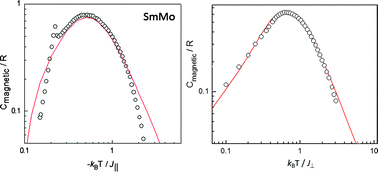Short-range correlations in d–f cyanido-bridged assemblies with XY and XY-Heisenberg anisotropy
Abstract
Two new d–f

Maintenance work is planned for Wednesday 1st May 2024 from 9:00am to 11:00am (BST).
During this time, the performance of our website may be affected - searches may run slowly and some pages may be temporarily unavailable. If this happens, please try refreshing your web browser or try waiting two to three minutes before trying again.
We apologise for any inconvenience this might cause and thank you for your patience.
* Corresponding authors
a Leiden Institute of Chemistry, Gorlaeus Laboratories, Leiden University, PO Box 9502, Leiden, The Netherlands
b Instituto de Ciencia de Materiales de Aragón, CSIC–Universidad de Zaragoza, Departamento de Física de la Materia Condensada, Zaragoza, Spain
c
Kamerlingh Onnes Laboratory, Leiden Institute of Physics, Leiden University, PO Box 9504, Leiden, The Netherlands
E-mail:
jongh@physics.leidenuniv.nl
Two new d–f

 Please wait while we load your content...
Something went wrong. Try again?
Please wait while we load your content...
Something went wrong. Try again?
S. Tanase, M. Evangelisti and L. J. de Jongh, Dalton Trans., 2011, 40, 8407 DOI: 10.1039/C1DT10310E
This is an Open Access article. The full version of this article can be posted on a website/blog, posted on an intranet, photocopied, emailed, distributed in a course pack or distributed in Continuing Medical Education (CME) materials provided that it is not used for commercial purposes.
To request permission to reproduce material from this article in a commercial publication, please go to the Copyright Clearance Center request page.
If you are an author contributing to an RSC publication, you do not need to request permission provided correct acknowledgement is given.
If you are the author of this article, you do not need to request permission to reproduce figures and diagrams provided correct acknowledgement is given. If you want to reproduce the whole article in a third-party commercial publication (excluding your thesis/dissertation for which permission is not required) please go to the Copyright Clearance Center request page.
Read more about how to correctly acknowledge RSC content.
 Fetching data from CrossRef.
Fetching data from CrossRef.
This may take some time to load.
Loading related content
